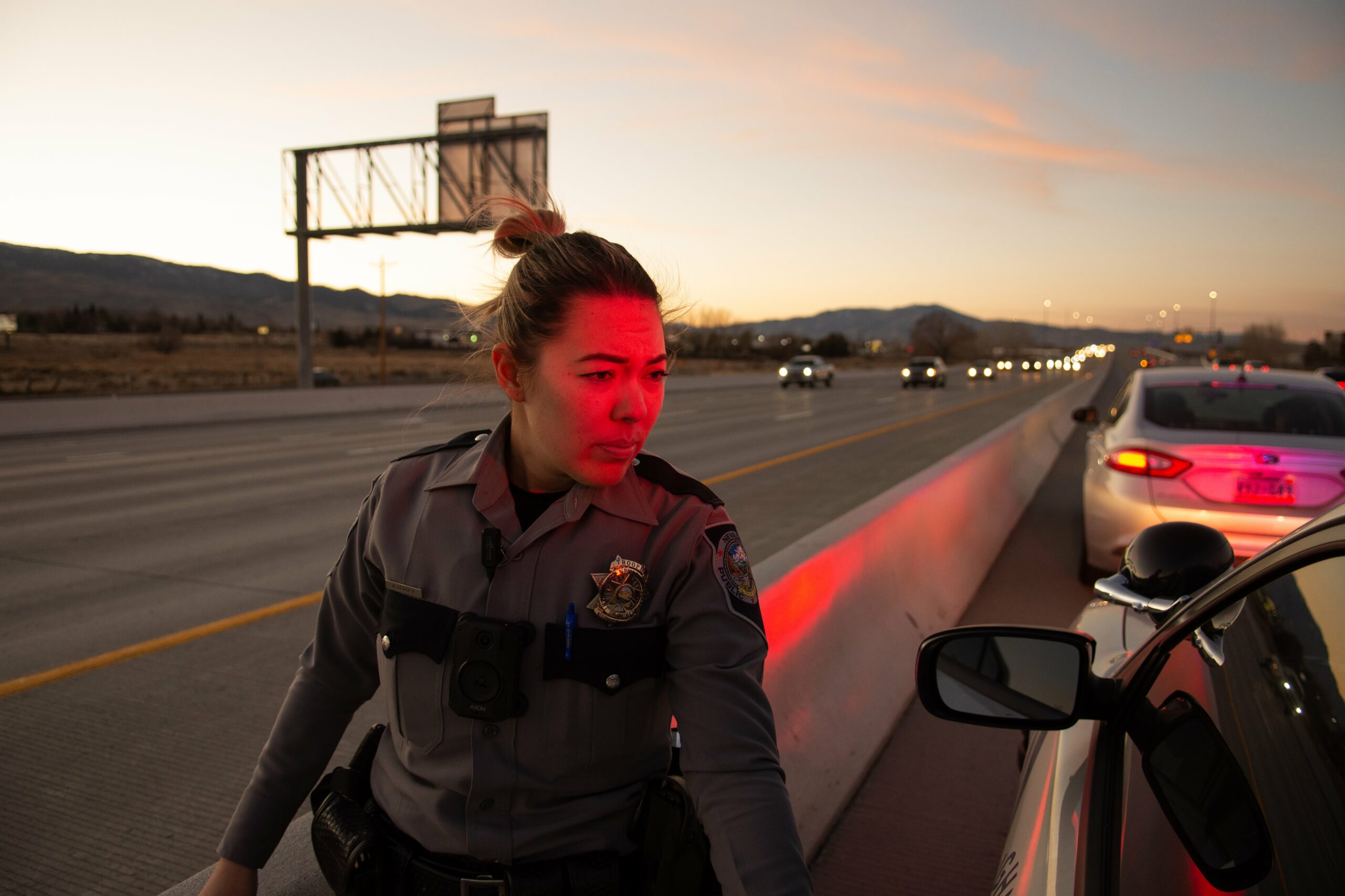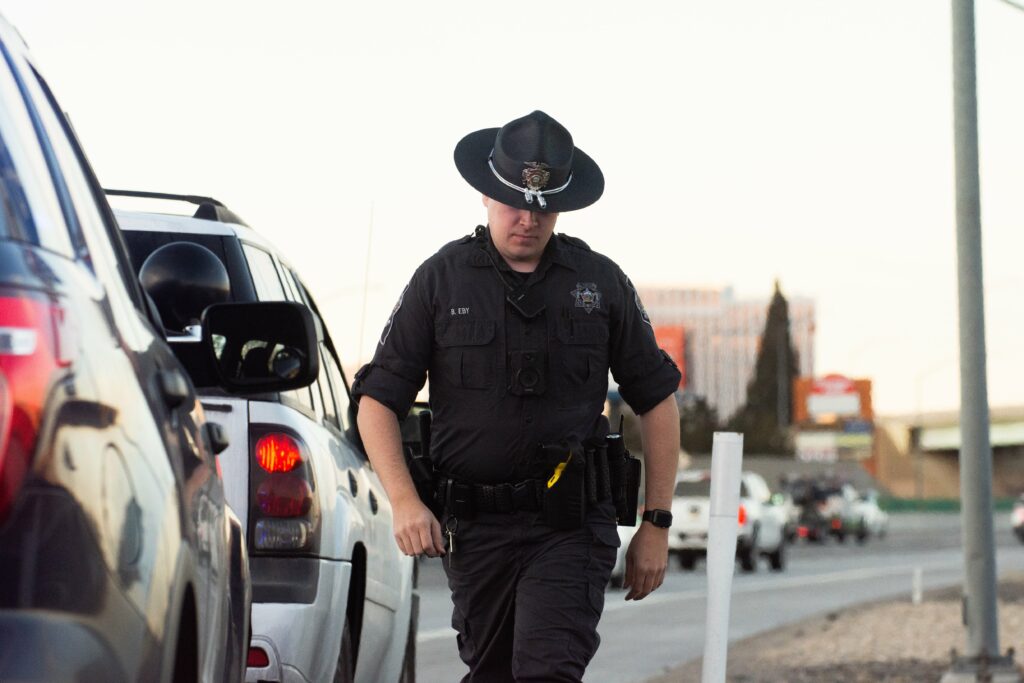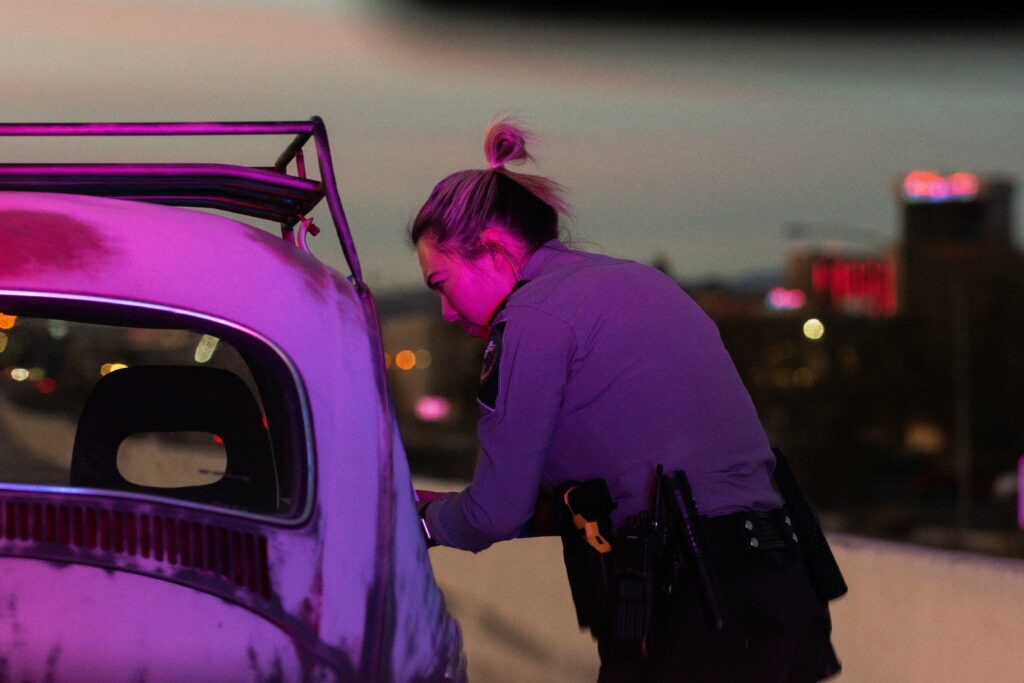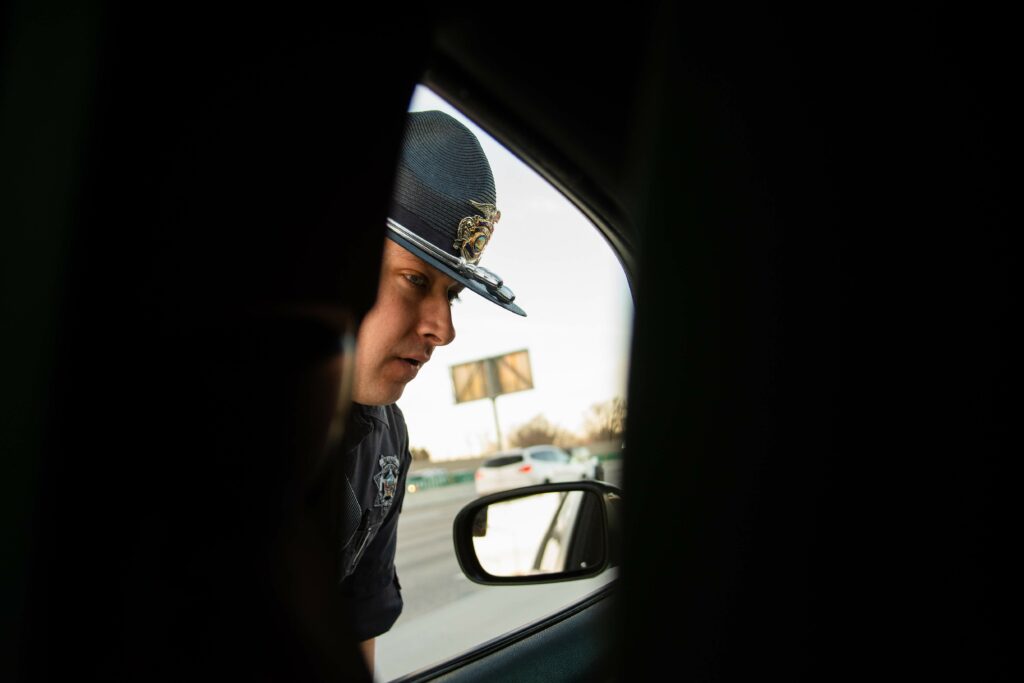Nevada may change DUI law to reflect the unique ways marijuana affects the body

Trooper Hannah DeGoey guides her silver Charger through Reno traffic as the sun sets, flipping on her radar from time to time to check the speed of cars whizzing by.
There’s a young driver who was speeding and driving friends around with expired insurance, and a man in a VW Bug who she saw using his cell phone on the freeway; she stops both and politely issues tickets. But mercifully, radio reports of a rollover on I-80 were false alarms, and nobody seems to be showing obvious signs of driving under the influence on this Friday night.
“I feel so strongly about getting drunk drivers off the road,” said DeGoey, who joined the Nevada Highway Patrol after years in a police department. “Even though our pay is less than the surrounding agencies, we're short-staffed just like everyone else, the mission of the highway patrol just really spoke to me.”
DeGoey is carrying on at a time when Nevada is at a crossroads: still trying to understand the implications of legalizing adult use marijuana three years ago, and how to ensure those who are driving when they shouldn’t face consequences without ensnaring those whose legal high has long since worn off. She has specialized training to detect impairment not just from alcohol, but marijuana and other drugs.
Still, it’s a murky proposition. Cannabis works through the body differently than alcohol, eluding clear-cut measurements like the 0.8 blood alcohol content threshold. Limitations on crash data record-keeping and the rise of “poly substance” use in which more than one chemical shows up in the blood at the time of a crash make it difficult to pin blame.
“In order to draw accurate conclusions we need more data regarding the role of marijuana use and traffic crashes. At present the State has a limited set of data to work with,” said Amy Davey, administrator of the Nevada Office of Traffic Safety. “What we do know based on 2016 through 2019 data is that a little over half of all fatal crashes in Nevada include the presence of one or more impairing substances in an individual involved in the crash.”
Democratic Assemblyman Steve Yeager, who’s chairing a committee that is spending the year developing recommendations on how to tweak Nevada law on marijuana DUIs, said he doesn’t think the sky is falling on road safety since cannabis became legal. Just as in the aftermath of Prohibition, states are increasingly allowing adults to make decisions about cannabis use.
“None of the evidence that was there made me think that we've had any sort of dramatic increase. I think we're more aware that people are using cannabis and we're more aware of the poly drug use where people are using multiple substances,” he said in an interview. “I think it's really hard to kind of come up with a correlation. … Even in the other states, some of the data that was presented, I thought it was really unclear.”
States that have gone through similar exercises, such as Michigan, have advised against setting any specific numbers on what constitutes a marijuana DUI, instead recommending officers determine on a case-by-case basis who is impaired.
In spite of the ambiguity, national traffic safety officials have narrowed its message to “If You Feel Different, You Drive Different.” At the end of the day, the state’s aim to zero out fatal roadway crashes could depend on individual decisions, and accountability could hinge on more subjective measures such as an officer’s observation of someone’s behavior than a single number from a lab reading.
“Of course we want zero fatalities, but the reality of us reaching it — I don't know if it seems within grasp sometimes,” DeGoey said. “We try to educate the public. We try to go on these joining forces campaigns … we do the best we can, but it comes down to the driver's responsibility of being a better driver.”

The science
Of the more than 100 different compounds in the cannabis plant called “cannabinoids,” the one most responsible for the high that comes from marijuana is delta 9 tetrahydrocannabinol, or THC. The psychotropic effects come when that compound binds to a receptor in the brain.
Nevada law specifies that a person is driving under the influence of marijuana if at least two nanograms per milliliter of delta 9 THC are found in the blood, and five nanograms per milliliter of the metabolite 11 hydroxy THC.
That so-called “per se” limit — a concrete number that triggers a DUI — rubbed many people who showed up to the interim committee’s inaugural meeting in January the wrong way. That’s because research shows specific quantities of THC are often unreliable predictors of impairment.
“It can't be attached to nanograms in the blood system, because I can line up a dozen, 100 patients … that will all test 50 times over the limit and show little or no impairment,” said Ralph Wenger, the owner of a marijuana cultivation facility in Clark County.
Wenger was referring to drug tolerance, which can develop in people who regularly use large quantities of marijuana. Over time, they are able to function more or less normally after ingesting levels of cannabis that would have a noticeable effect on uninitiated users.
Advocates pointed to a warning from the Food and Drug Administration that people should not drive after taking the medication Marinol, a synthetic form of delta 9 THC, “until it is established that they are able to tolerate the drug and to perform such tasks safely.”
“I feel like this is an incredible acknowledgement from the FDA acknowledging that experienced consumers tend to become tolerant to many of cannabis’ effects, including the effects upon psychomotor skills,” said Madisen Saglibene, executive director of the Nevada and Las Vegas chapters of The National Organization for the Reform of Marijuana Laws (NORML).
There’s also a difference in how THC breaks down over time. The body absorbs alcohol and reaches peak blood alcohol levels about 10-25 minutes after consumption, then metabolizes it in a linear fashion over time, with all of it excreted over the course of seven to nine hours.
But there are two distinct phases through which the body processes THC. First comes the rapid elimination phase, when it takes about six minutes to halve the amount of the compound in the body. Then comes the long-term elimination phase, in which it takes about 22 hours to achieve another “half-life.”
Biologically, that’s because THC is rapidly absorbed into fat tissue but then slowly released into blood circulation. A 2008 study from Germany showed that habitual users can have detectable — even DUI-worthy levels — in their blood for days after they began abstaining.
And then, there’s the trouble with THC producing a delayed high. The effect of cannabis on the central nervous system happens after the initial rapid elimination phase, meaning concentrations of the chemical in the blood have often plummeted to below the legal limit by the time serious impairment of the brain kicks in an hour or more after consumption.
Public commenters said they feared that their lives and careers could be devastated by a DUI stemming from use that is no longer impairing them. Wenger said one of his employees, a medical marijuana patient apprehended at a DUI checkpoint last Super Bowl Sunday, has faced multiple court dates and now has an ignition interlock device to drive her car as a result.
As public commenter Chris Thompson put it, “I just don't think a woman who took an edible the previous night to go to sleep for her chemotherapy treatments shouldn't be able to drive the next afternoon to go to her oncology appointment.”
Yeager, the chair of the committee, has expressed discontent over the current protocol, even though he acknowledged a lingering fear of drunken and drugged driving.
“I think I speak for everyone on this panel that we are very interested in making sure we don't have impaired drivers on the road,” he said. “We are not looking to authorize impaired people to drive. What we're trying to do in this committee is figure out how do we make that determination when it comes to cannabis?”

The Jessica Williams case
One of the most prominent Nevada cases involving a marijuana DUI was that of Jessica Williams, who had visited Valley of Fire State Park and smoked some marijuana there with friends in the year 2000. On the way back, she fell asleep behind the wheel and fatally hit six youths who were picking up trash on the side of Interstate 15 as court-ordered community service.
While a jury found that Williams was not impaired and had simply fallen asleep, the “per se” law that allowed no detectable amount of marijuana in the body whatsoever forced a DUI conviction. She ended up serving 20 years and was only released on parole in recent months.
“We need to eliminate the per se levels on the marijuana,” her lawyer, John Glenn Watkins, told the legislative interim committee. “I want to be fair to everybody in the state of Nevada or anybody who comes to the state of Nevada. We need to eliminate that because we don't need to have non impaired people prosecuted, convicted of DUI.”
Still, six states had “per se” limits as of 2019, ranging from 1 nanogram per milliliter in Pennsylvania to 5 in Montana, Washington and Colorado.
Yeager, a former public defender, acknowledged that it might be harder for prosecutors to prove a DUI case when they can’t just use a lab test result. He expects more opposition from law enforcement and prosecutors in future meetings.
“I think some of those folks who are in that world would like it to stay like it is, because having a black and white rule is easy — it's easy to enforce,” Yeager said. “It doesn't make it just or right.”
He said judges may have to make more subjective decisions, as they do for drivers under the influence of prescription drugs, which don’t have per se limits.
“When you're looking at that question and you have no blood test and you have no level, you're looking at things like, well how does the person act, what did they say to the officer and with the field sobriety test, almost everybody now has body cameras,” Yeager said. “The judge can actually watch the field sobriety test and you can see how the person did and you can see what they were saying. That's just going to be a little bit more subjective than a blood test.”

The statistics
While Nevada crashes where only alcohol was involved fell by 16 percent from 2017 to 2018, the number of crashes involving any combination of drug and/or alcohol jumped by 9 percent.
But with just one year of data, “this system has not tracked all impairing substances over a long enough period of time for us to draw conclusions” about causes or trends, Nevada officials said.
Federal DUI record-keeping is evolving as marijuana becomes more prevalent, but still lacks some details.
In the past, reports to the national Fatality Analysis Reporting System were only able to accommodate information for up to three substances found in a crash subject’s system. That’s a problem when, for example, the Washington state toxicologist found up to 25 substances in a person’s blood.
Even with the update, however, the reports do not indicate the quantity of a substance in the person’s blood. So while it may report that marijuana was present at a crash, it’s hard to tell how much there was.
While it’s difficult to give the public the kind of clear-cut message it gives regarding alcohol, the National Highway Traffic Safety Administration since 2018 has run a major public information campaign not to get behind the wheel if they don’t feel normal.
“Driving is a complex task, and one that requires a person be in full possession of their mental and physical capabilities,” Davey said. “We all share the same roads and driving while impaired by any substance impacts the safety of all other drivers, pedestrians, bicyclists and motorcyclists on the roadway.”

The solutions
The authors of a marijuana DUI study last year in Michigan felt strongly that a DUI should be based on the results of field sobriety tests rather than a hard-and-fast number. Research has shown that the horizontal gaze nystagamus test that is considered the most reliable for alcohol impairment is less reliable for detecting cannabis impairment. The tests considered best for identifying marijuana impairment are considered a finger to nose test and the modified Romberg balance test.
They also recommended more research to validate field sobriety tests for detecting drugged driving, and more advanced training for officers on detecting impairment.
Nevada has specially trained certain officers how to look for impairment. The Office of Traffic Safety has received a grant from the Governors’ Highway Safety Association and Responsibility.org and is sponsoring training for law enforcement officers for roadside detection of marijuana impairment, which teaches advanced skills for recognizing signs of marijuana driving impairment.
Yeager said he doesn’t anticipate the committee, after months of meetings, will come up with set numbers to recommend lawmakers adopt in the 2021 session. Jennifer Noble of the Nevada District Attorneys Association acknowledged that “it’s hard to pinpoint a magic amount that’s going to correlate with impairment.”
But she said that if per se limits are removed, “all we’re left with is the observations of the officer,” and that could be unreliable if those officers are not properly trained on the way different substances impair drivers. Changing the law without paying for more training would be “putting the cart before the horse.”
“Ideally what would be great is if we had more drug recognition experts,” she said. “It enhances our ability to prove those beyond a reasonable doubt.”
Still, groups such as NORML are pushing for changes so that their member base — marijuana consumers — have peace of mind about legal consumption.
“There is a lot of fear because they’re either driving around to get to work or driving for a living. People are just wanting clarification,” Saglibene said.
Marijuana may be widely legal, she said, but there is much work still to be done to change Nevada laws to match growing societal acceptance.
“It feels like it’s really just beginning,” she said.
Updated at 8:40 a.m. to reflect DeGoey previously worked at a police department.
